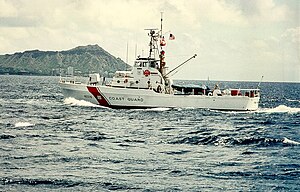Point-class cutter
 |
|
| Class overview | |
|---|---|
| Builders: |
|
| Operators: |
|
| Preceded by: | Cape-class 95' patrol boat |
| Succeeded by: | Marine Protector-class 87' patrol boat |
| Built: | 1960–1970 |
| In commission: | 1960–2003 |
| Completed: | 79 |
| Retired: | 79 |
| General characteristics (1960) | |
| Type: | Patrol boat (WPB) |
| Displacement: | 60—69 tons |
| Length: | 82 ft 10 in (25.25 m) |
| Beam: | 17 ft 7 in (5.36 m) max |
| Draft: | 5 ft 11 in (1.80 m) |
| Propulsion: |
|
| Speed: | 16.8 kn (31.1 km/h; 19.3 mph) (1960) |
| Range: |
|
| Complement: | domestic service, 8 men; (Vietnam service, 2 officers, 8 men) |
| Armament: |
|
The Point-class cutter was a class of 82-foot patrol vessels designed to replace the United States Coast Guard's aging 83-foot wooden hull patrol boat being used at the time. The design utilized a mild steel hull and an aluminum superstructure. The Coast Guard Yard discontinued the building of the 95-foot Cape-class cutter in order to have the capacity to produce the 82-foot Point-class patrol boat in 1960. They served as patrol vessels used in law enforcement and search and rescue along the coasts of the United States and the Caribbean. They were replaced by the 87-foot Marine Protector-class coastal patrol boats beginning in the late 1990s.
Following the Coast Guard custom in place in 1960 of not naming vessels under 100 feet in length, the first 44 Point-class patrol boats were only identified by their hull number using the scheme of WPB-823xx, where 82 was the design length of the hull. Beginning in January 1964, the Coast Guard started naming all vessels 65 feet in length and over; the 82-foot patrol boats were all given geographical "Point" names.
The design of the 82-foot patrol boat actually began in the early 1950s with the introduction of the 95-foot patrol boat, which was introduced to replace the aging wooden gasoline powered 83-foot patrol boats that were produced during World War II. The 95-foot patrol boat was originally developed as a search and rescue boat to replace the less capable 83-foot boat. With the outbreak of the Korean War and the requirement by the Coast Guard to secure port facilities in the United States under the Moss-Magnuson Act, the complete replacement of the 83-foot boat was deferred and the 95-foot boat was used for harbor patrols. With the goal of reducing manning requirements in mind, the Point-class patrol boat was designed to accommodate an eight-man crew, which was a reduction from the 15-man crews of the Cape-class cutter. Production started in early 1960 at the Coast Guard Yard at Curtis Bay, Maryland and continued through late December 1963, producing 44 boats. The first 30 boats were powered by two 600 horsepower (450 kW) Cummins diesel engines; except for 82314 (later Point Thatcher), which was powered by two 1,000 horsepower (750 kW) gas turbine engines with controllable pitch propellers and 82318 (later Point Herron) which had two 800 horsepower (600 kW) Cummins diesels installed. Beginning in March 1962 with 82331 (later Point Marone), all boats were equipped with two 800-horsepower Cummins diesel engines. All were equipped with twin propellers. Eventually all boats were upgraded to the same 800-horsepower main engines used in the later production. In 1966 a contract for the production of 25 additional boats was awarded to J.M. Martinac Shipbuilding Corp. of Tacoma, Washington and all 25 were equipped with the twin 800-horsepower engines of the 1962 and later Yard production. In 1970, the last nine boats of the class were produced at the Yard utilizing the 800-horsepower design of the rest of the class. Those boats in service in 1990 were refit with Caterpillar diesel main drive engines. Engine exhaust was ported through the transom rather than through a conventional stack and this permitted a 360-degree view from the bridge; a feature that was very useful in search and rescue work as well as a combat environment.
...
Wikipedia
